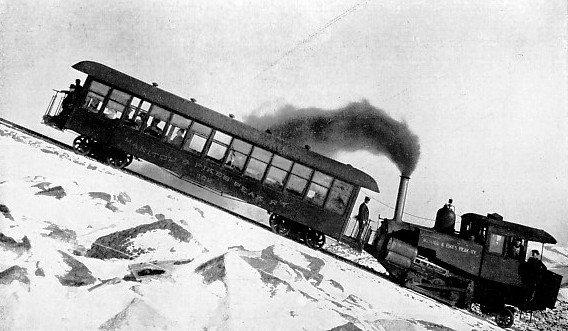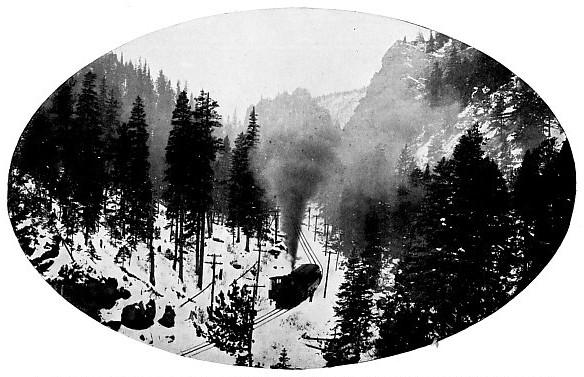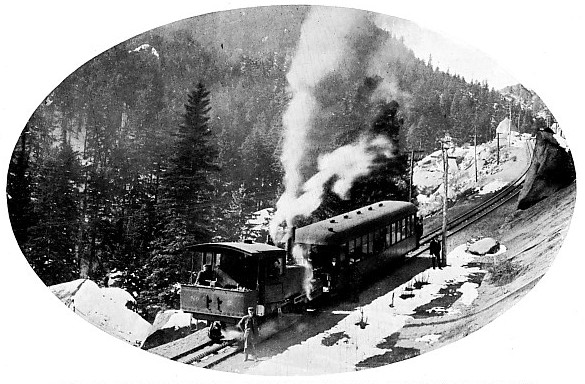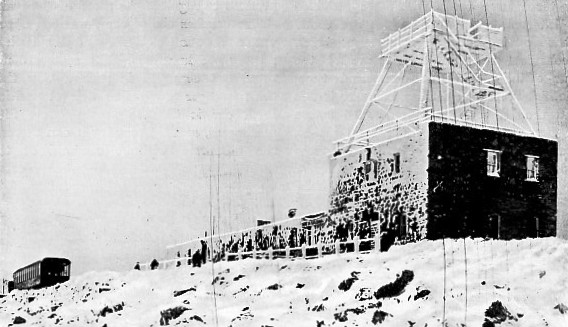
© Railway Wonders of the World 2024 | Contents | Site Map | Contact Us | Cookie Policy


The Pike’s Peak Rack Railway
The story of a line which climbs a mountain 14,417 feet high

ON THE STEEPEST PART OF THE RAILWAY above the timber line, where it rises 1 in 4, showing the special type of locomotive.
WHEN, in 1806, Captain Zebulon M. Pike first beheld from afar the majestic proportions of the peak which now bears his name, rising above the dishevelled mountainous knot found in the State of Colorado, naturally he sought to scale its topmost heights. But his determination and endurance proved insufficient for the task. This is not surprising, seeing that he was not equipped for an exacting mountaineering expedition, whilst this hoary old man of the American Rockies is no mean crest, seeing that it beetles 14,147 feet into the clouds.
After the conquest of the Rigi and other Alpine crests in Europe, enterprising Americans, resolved not to be eclipsed by the Old World, suggested the railway subjugation of Pike’s Peak. The proposal was startling, as this is a remarkable mountain. It is not a mere jagged nose of rock thrusting itself higher from its fellows into the sky, but lifts its head above a broad expansive plain. As a coign of vantage its crest is difficult to surpass in North America, because wonderful vistas of unparalleled magnificence are unfolded over an area of 60,000 square miles.
From the viewpoint of the railway engineer it possesses many attractions, inasmuch as it not only indicates the highest point between the two poles to which the rack railway has been carried for tourist purposes, but the consummation of the task bristled with extraordinary difficulties.
The engineer was spurred to its mastery with the ribbon of steel by the striking stories of beautiful panoramas which were related by the few mountaineers who toiled afoot to its summit. Could the requisite financial assistance be raised to carry a line from base to crest? That was the problem. There was no anxiety about sufficient traffic being forthcoming to render the undertaking remunerative. If the crest were brought within the reach of the masses, who are not prepared to experience the hardship and peril of climbing among ugly crags, and braving the unpropitious elements, thousands would avail themselves of the opportunity to proceed to the top by rail, providing the element of safety were above suspicion.
So reasoned an enterprising engineer in 1884. He succeeded in infusing a number of colleagues with his enthusiasm and a start was made. The promoters of the scheme essayed to scale the mountain with a maximum grade of 1 in 20, and to achieve this end plotted a circuitous route 30 miles in length, in which distance 7,518 feet in altitude were to be overcome, Manitou, the starting point, being at an elevation of 6,629 feet above sea level.
The railway was forthwith commenced, but when it had been graded a distance of eight miles, and was ready to receive the metals, the scheme was assailed vigorously on technical grounds. This unexpected criticism dried up the fount of financial support; the project had to be abandoned.
The triumphs of the Swiss engineers with the rack railway and the widespread successes, from the commercial point of view, that were rail being reaped by the provision of transportation facilities to inaccessible heights caused the Pike’s Peak project to be resuscitated. But the new project was vastly dissimilar from that originally evolved. The fathers of the new idea decided to follow the shortest practicable route between the base and crest of the mountain. The maximum gradient would be steep: that, however, was of secondary importance, seeing that the cog-
The preliminary surveys were run in 1888, the greater part of the year being occupied in this initial task. The little band of men spent a racking time among the precipitous cliffs, over which they were slung by chains to toil upon narrow ledges scarcely wide enough to permit one to turn round, scrambling over ragged crags, facing biting winds, blinding snows and lashing rains. Their physical endurance and nerve were taxed to the utmost; accidents were frequent, and thrilling escapes numerous. But they completed their work successfully, and the sum of their efforts showed that there were no insuperable reasons why the two extremities of the peak should not be connected by a steel link some nine miles in length.
The surveyors emphasised one drawback. “There will be snow, and plenty of it, against which to contend”. This factor had been brought home to them with painful reality. Banks 30 and 40 feet in depth were by no means uncommon. Often they had been forced to tunnel their way through the heavy white blanket which wreathes Pike’s Peak for more than six months in the year.
The trials and tribulations that would confront the navvies in the higher reaches were not exaggerated, but they were fully indicated. The rarefied atmosphere taxes the lungs when one is engaged in physical exertion. On the summit the barometer stands at about 17 inches, and water boils at 184°, instead of 212° F. It was realised that labour would be very exhausting, but the promoters concluded that by handling the men carefully this disadvantage could be mitigated very appreciably.

A CHARACTERISTIC DEFILE on the Pike's Peak Railway below the timber line.
It was decided to use the Abt rack system, which had proved so successful in Europe, upon the plans outlined by the surveyors, but the apprehensions of the timid were not overlooked. “There must be no suspicion of danger”, urged the guiding spirit of the enterprise. “The line must be built as strongly as possible; every device to ensure unquestionable safety in travelling must be adopted regardless of expense, so that the most nervous passenger may feel just as secure when climbing up a bank of 1 in 4 as when riding over level ground in a railway car”. This adjuration was carried out to the letter. Nothing was left to chance; nothing completed in a perfunctory manner. The Pike’s Peak Railway stands among the most substantially built lines of its class in the world. The United States tourist is not so familiar with mountaineering by rail as travellers in Europe, and the idea of crawling to a height of 14,147 feet above sea level, while fascinating, inevitably provoked certain misgivings in the early days.
The railway builders started on their task from Manitou in 1889. The first stretch was comparatively easy, as it ran among the foothills, but as the mountain flank proper was attacked, the difficulties became greater and greater. In the lower levels the route threads dense timber expanses, where the right-
The rack-
The rack-
The railway measures 47,992 feet in length from end to end. The average gradient is 844·8 feet per mile, the maximum rise being 25 in 100. The sharpest curves are of 16°, that is, a radius of 358 feet. In order to contribute to the rigidity and solidity of the track, and to prevent it moving or sliding under its own weight, which is enormous, or by the forces of sudden expansion and contraction of the metal, it is anchored to the solid rock at distances ranging from 200 to 1,400 feet, according to the severity of the gradient; 146 of these anchors are used throughout its entire length.
It was when the timber line was passed that the greatest trials and hardships in construction were encountered. The mountain surface was scarred in a terribly rough manner. Here projecting pinnacles, with their sides as polished as a mirror by the elements, had to be blown away; there ledges had to be cut in the side of the solid rock-
As may be supposed, the engine in making such a continuous and heavy pull towards the clouds develops an intense thirst. The water supply at places was a searching problem, but it has been met effectively by three large tanks which are provided at intervals. The locomotives are somewhat quaint-
On such a railway, abounding with numerous steep banks, the braking arrangements necessarily are of supreme importance. From the sides of the driving cog-
The coaches are of the American observation Pullman pattern, and for such a railway are luxurious. The seats are not tilted but arranged in such a way that the passenger always has a level position Each car is able to accommodate fifty passengers, and if necessary it can descend the mountain without the aid of the locomotive, because each bogie carries cogwheels engaging with the rack, through which powerful individual braking can be applied to secure complete control. This enables the coach to be stopped instantly and independently of the locomotive. As is usual upon rack railways, the engine pushes the coach up hill, and precedes it on the descent, the two never being coupled together.

VIEW OF THE TRACK OF THE PIKE’S PEAK RAILWAY, showing the rack-
Between the two terminal points there are six intermediate stations, each of which provides facilities for viewing some scenic spectacle. After the timber line is passed at 11,578 feet, the railway enters upon its steepest, and at the same time the wildest part of its journey, to the summit station, beside the Government signal station. One very curious effect often is observed when climbing the mountain. Every inch of the road is uphill, and yet after toiling up a steep bank, and when about to enter a stretch of more moderate gradient, the road ahead appears to run downhill. The round journey -
Though innumerable obstacles had to be overcome to bring about the realisation of the Manitou and Pike’s Peak Railway, they are equalled fully by the herculean efforts that have to be put forth to open and maintain the line during the season.
“Snow,” narrated Mr. Sells, the chief engineer, to me, “is our greatest bugbear, and it is of a nature seldom experienced upon any other railway. On the upper five miles it runs from 3 to 35 feet in depth, and it packs as hard as masonry. Running through the banks are stratae of ice, representing the packing of the heavy snows during the winter. It is these frozen layers which tax our efforts so severely. There is no mechanical appliance which can cope with them. What we do is to cut trenches so that the mass is divided into blocks about 9 feet square. These are then transferred to a flat car by a scoop-
“Above the timber line the snow drifts easily, as there are no obstacles to its scudding race over the mountain slopes. In some seasons we have had to open the line as many as fifteen times. June 1st is the scheduled day on which the first train runs to the summit, and as a rule we are not troubled with snow after the 15th of that month. But occasionally we have to haul out our snow-
Despite these drawbacks, and although the railway is open only for a very brief period, it is a hot favourite with tourists. During the height of the season the company maintains what it calls a semi-
Notwithstanding the complete success of the Pike’s Peak Railway, the rack system has not been utilised very extensively in the United States. Even the first railway of this type, that up Mount Washington, in New Hampshire, is doomed. Another
route has been surveyed, and it is intended to lay down an electric road working throughout by adhesion purely and simply. Still, the Pike’s Peak line possesses a unique distinction. It is the longest continuous road built upon this principle in the world. In view of the fact that the rack railway is being superseded, at all events for mountaineering purposes, by cheaper systems for achieving the same end, it is very doubtful whether this line ever will be eclipsed.
The total cost of the undertaking was £200,000, representing an average of £22,000 per mile, so that it ranks as one of the most expensive rack lines which has been laid down in any part of the world. Since its completion in 1890 it has been the means of conveying thousands of travellers to the mountain top. From the European point of view, and bearing in mind the comparatively low fares charged on the Swiss mountain rack railways, the ascent of Pike’s Peak by this medium appears somewhat expensive, the return journey costing 20s., or over 1s. 1d. per mile. But bearing in mind the cost of construction, the heavy maintenance expenses, and the brief period of the running season, in conjunction with the fact that it is essentially a pleasure line, the fare is by no means excessive.
“Since this line was opened,” proudly confesses the engineer, “we have never had a single personal injury arising from its operation. It cost a lot to build, but absolute and unquestionable safety was the factor which guided its consummation, so that not even the most timid need entertain the slightest apprehensions. ‘A substantial road’ was our watchword, and the policy has been repaid amply by the complete financial success of its operation.”

THE CREST OF PIKE’S PEAK, 14,147 FEET ABOVE THE SEA: THE ENGINE IS ATTACHED AS A “PUSHER”
You can read more on “Rack Rail Locomotives”, “The Rigi Railway” and “Wonderful Alpine Ascents” on this website.